Strategies for Managing Cross Cultural Issues in Organizations
VerifiedAdded on 2021/06/14
|12
|2664
|72
Report
AI Summary
This report examines the critical aspects of cross-cultural issues in the workplace, addressing challenges related to ethnic and cultural differences, language and communication barriers, and gender discrimination. It provides a detailed analysis of these problems, highlighting their impact on workforce performance and organizational dynamics. The report delves into the significance of globalization and its influence on business processes, emphasizing the need for adaptable management strategies. It also explores the importance of inclusive leadership and the role of management in fostering a diverse and harmonious work environment. Furthermore, the report offers practical, recommended actions for managing these issues, including promoting equal treatment, facilitating effective communication, and implementing non-discrimination policies. The aim is to provide a comprehensive understanding of cross-cultural challenges and to offer strategies for creating a more inclusive and productive workplace.
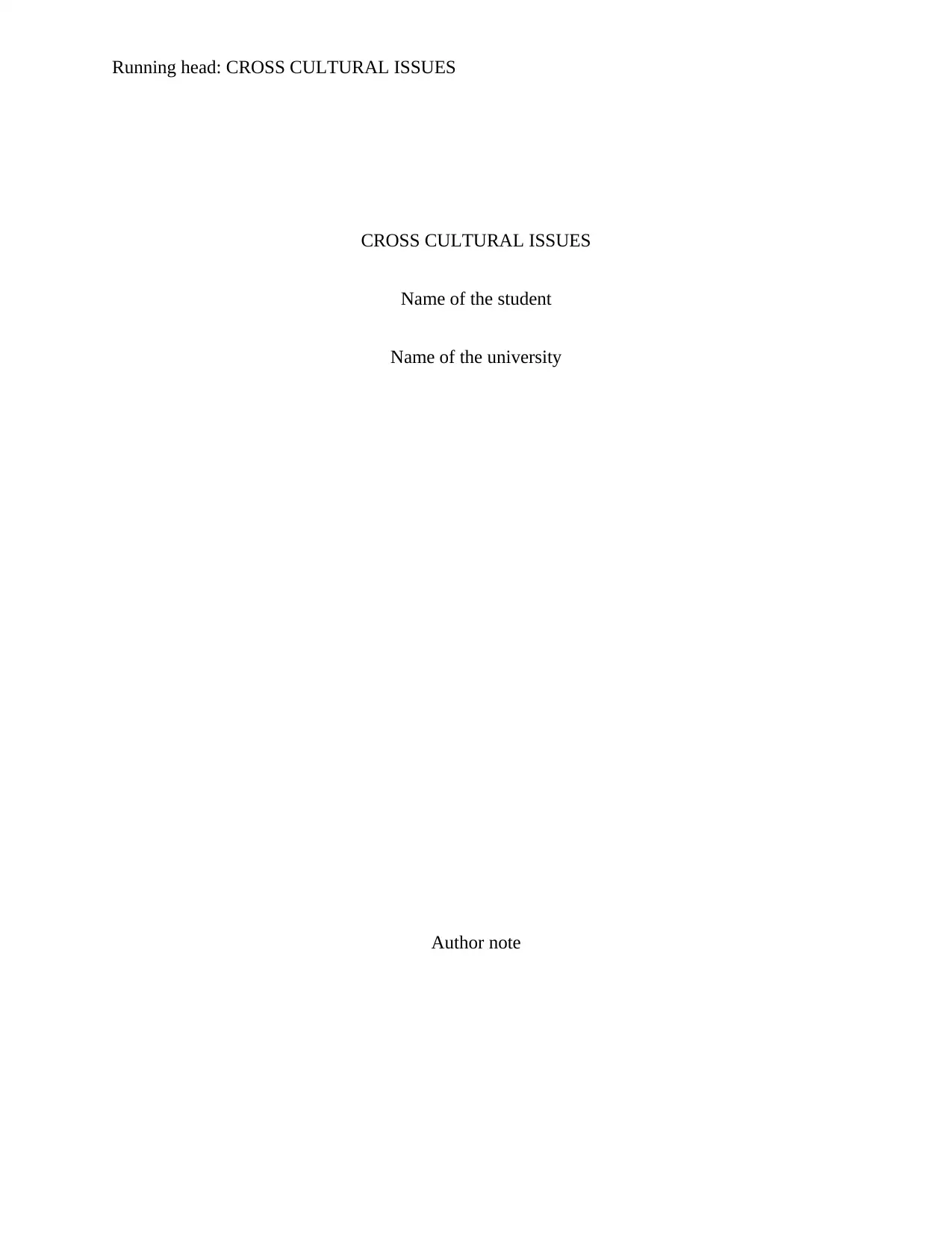
Running head: CROSS CULTURAL ISSUES
CROSS CULTURAL ISSUES
Name of the student
Name of the university
Author note
CROSS CULTURAL ISSUES
Name of the student
Name of the university
Author note
Paraphrase This Document
Need a fresh take? Get an instant paraphrase of this document with our AI Paraphraser
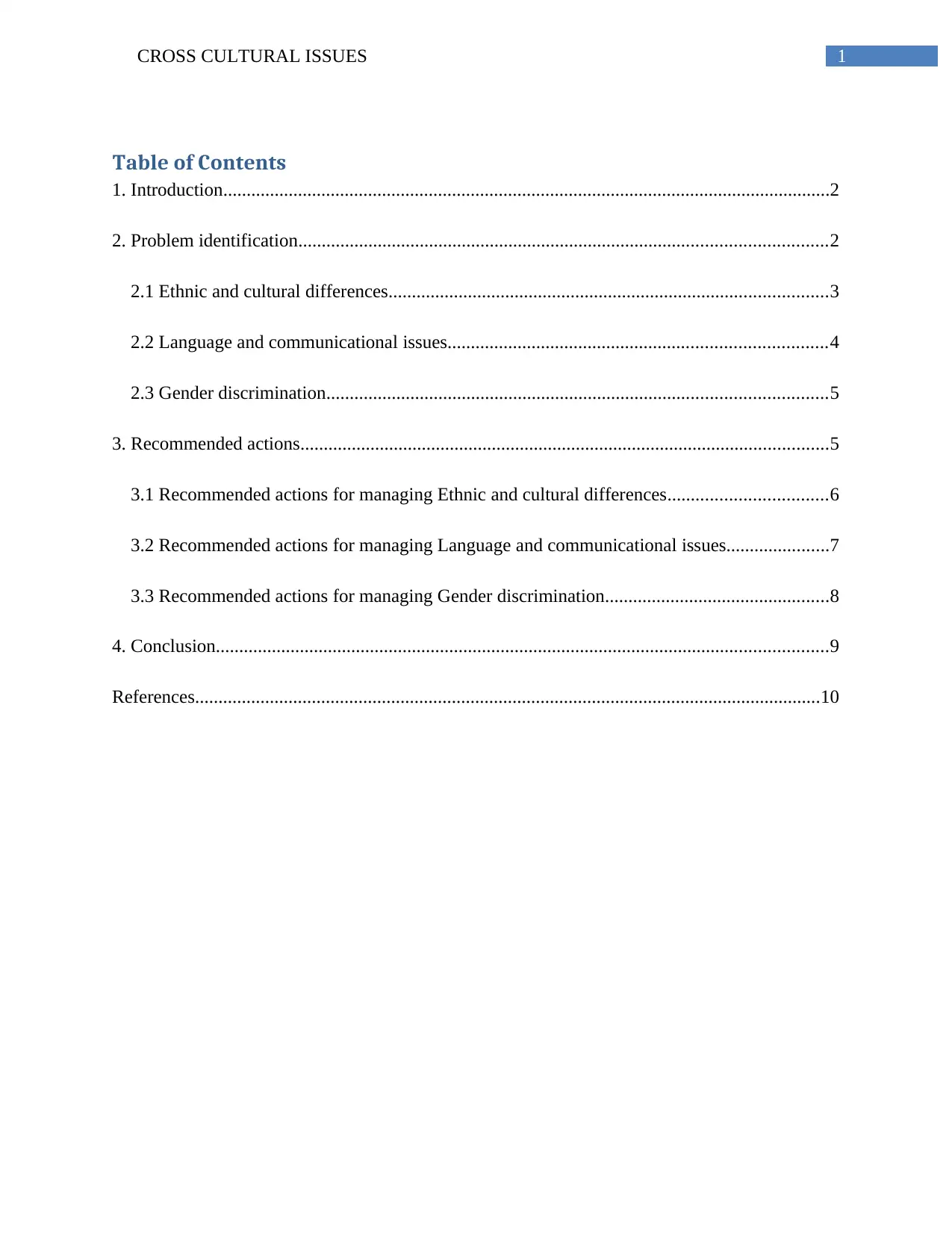
1CROSS CULTURAL ISSUES
Table of Contents
1. Introduction..................................................................................................................................2
2. Problem identification.................................................................................................................2
2.1 Ethnic and cultural differences..............................................................................................3
2.2 Language and communicational issues.................................................................................4
2.3 Gender discrimination...........................................................................................................5
3. Recommended actions.................................................................................................................5
3.1 Recommended actions for managing Ethnic and cultural differences..................................6
3.2 Recommended actions for managing Language and communicational issues......................7
3.3 Recommended actions for managing Gender discrimination................................................8
4. Conclusion...................................................................................................................................9
References......................................................................................................................................10
Table of Contents
1. Introduction..................................................................................................................................2
2. Problem identification.................................................................................................................2
2.1 Ethnic and cultural differences..............................................................................................3
2.2 Language and communicational issues.................................................................................4
2.3 Gender discrimination...........................................................................................................5
3. Recommended actions.................................................................................................................5
3.1 Recommended actions for managing Ethnic and cultural differences..................................6
3.2 Recommended actions for managing Language and communicational issues......................7
3.3 Recommended actions for managing Gender discrimination................................................8
4. Conclusion...................................................................................................................................9
References......................................................................................................................................10
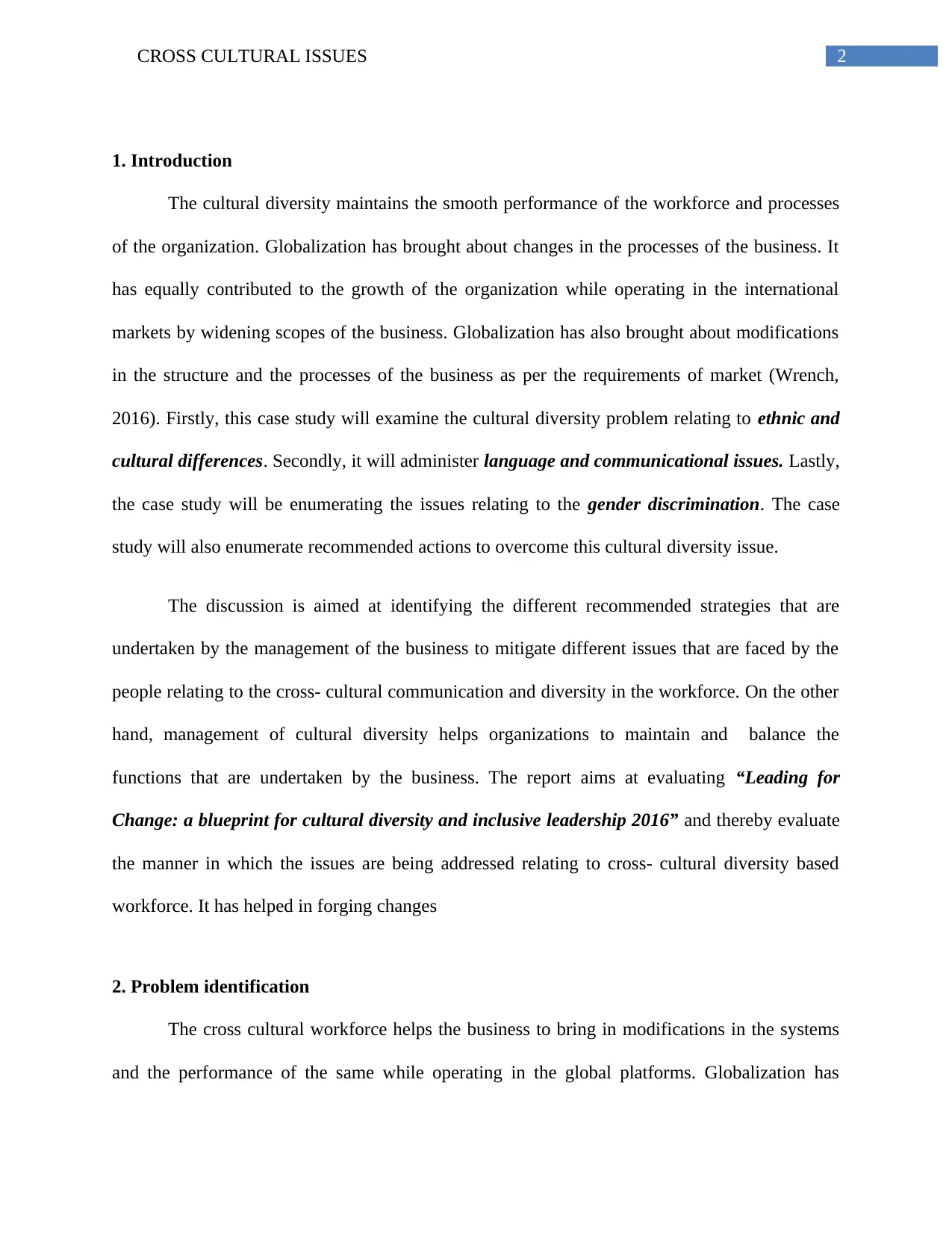
2CROSS CULTURAL ISSUES
1. Introduction
The cultural diversity maintains the smooth performance of the workforce and processes
of the organization. Globalization has brought about changes in the processes of the business. It
has equally contributed to the growth of the organization while operating in the international
markets by widening scopes of the business. Globalization has also brought about modifications
in the structure and the processes of the business as per the requirements of market (Wrench,
2016). Firstly, this case study will examine the cultural diversity problem relating to ethnic and
cultural differences. Secondly, it will administer language and communicational issues. Lastly,
the case study will be enumerating the issues relating to the gender discrimination. The case
study will also enumerate recommended actions to overcome this cultural diversity issue.
The discussion is aimed at identifying the different recommended strategies that are
undertaken by the management of the business to mitigate different issues that are faced by the
people relating to the cross- cultural communication and diversity in the workforce. On the other
hand, management of cultural diversity helps organizations to maintain and balance the
functions that are undertaken by the business. The report aims at evaluating “Leading for
Change: a blueprint for cultural diversity and inclusive leadership 2016” and thereby evaluate
the manner in which the issues are being addressed relating to cross- cultural diversity based
workforce. It has helped in forging changes
2. Problem identification
The cross cultural workforce helps the business to bring in modifications in the systems
and the performance of the same while operating in the global platforms. Globalization has
1. Introduction
The cultural diversity maintains the smooth performance of the workforce and processes
of the organization. Globalization has brought about changes in the processes of the business. It
has equally contributed to the growth of the organization while operating in the international
markets by widening scopes of the business. Globalization has also brought about modifications
in the structure and the processes of the business as per the requirements of market (Wrench,
2016). Firstly, this case study will examine the cultural diversity problem relating to ethnic and
cultural differences. Secondly, it will administer language and communicational issues. Lastly,
the case study will be enumerating the issues relating to the gender discrimination. The case
study will also enumerate recommended actions to overcome this cultural diversity issue.
The discussion is aimed at identifying the different recommended strategies that are
undertaken by the management of the business to mitigate different issues that are faced by the
people relating to the cross- cultural communication and diversity in the workforce. On the other
hand, management of cultural diversity helps organizations to maintain and balance the
functions that are undertaken by the business. The report aims at evaluating “Leading for
Change: a blueprint for cultural diversity and inclusive leadership 2016” and thereby evaluate
the manner in which the issues are being addressed relating to cross- cultural diversity based
workforce. It has helped in forging changes
2. Problem identification
The cross cultural workforce helps the business to bring in modifications in the systems
and the performance of the same while operating in the global platforms. Globalization has
⊘ This is a preview!⊘
Do you want full access?
Subscribe today to unlock all pages.

Trusted by 1+ million students worldwide
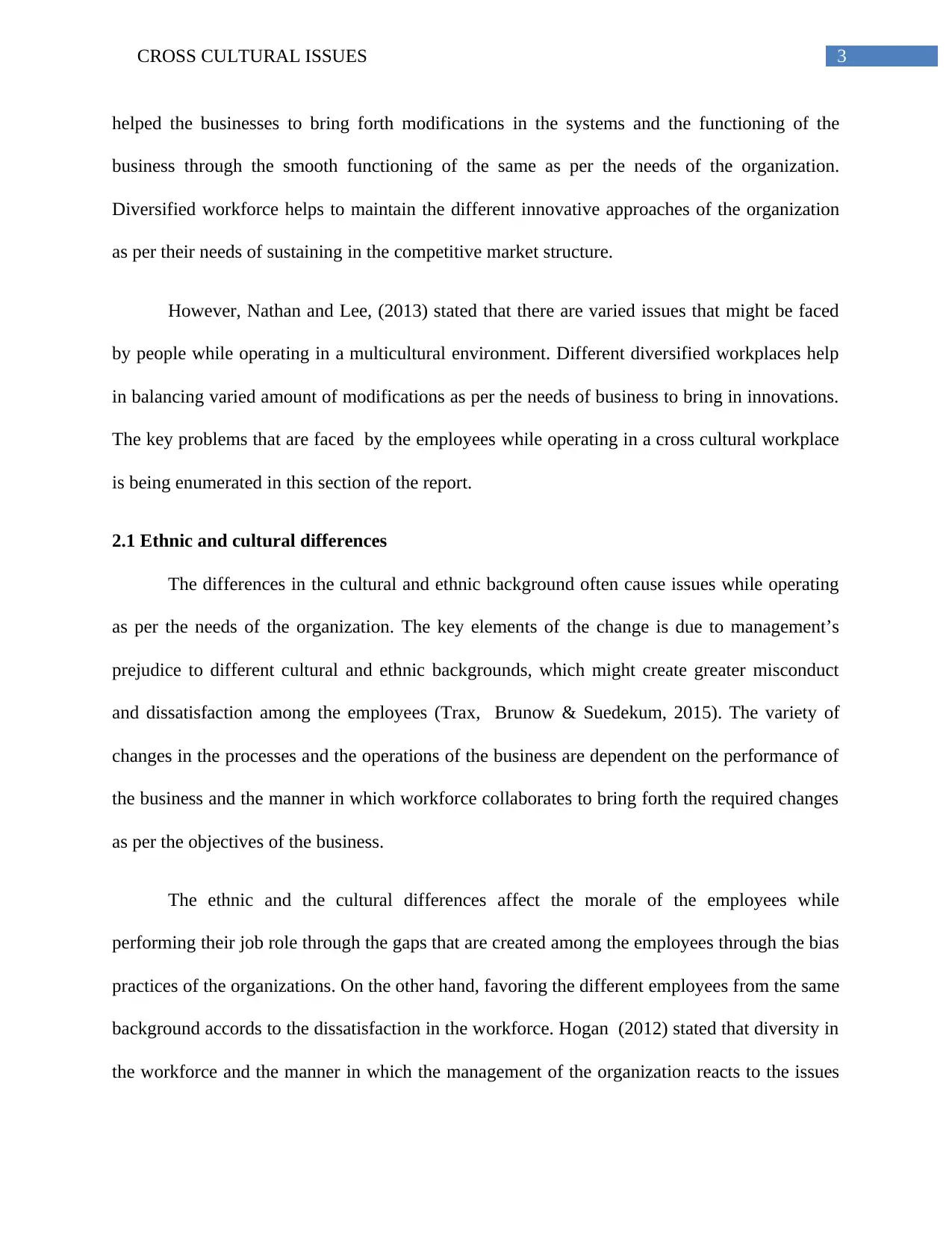
3CROSS CULTURAL ISSUES
helped the businesses to bring forth modifications in the systems and the functioning of the
business through the smooth functioning of the same as per the needs of the organization.
Diversified workforce helps to maintain the different innovative approaches of the organization
as per their needs of sustaining in the competitive market structure.
However, Nathan and Lee, (2013) stated that there are varied issues that might be faced
by people while operating in a multicultural environment. Different diversified workplaces help
in balancing varied amount of modifications as per the needs of business to bring in innovations.
The key problems that are faced by the employees while operating in a cross cultural workplace
is being enumerated in this section of the report.
2.1 Ethnic and cultural differences
The differences in the cultural and ethnic background often cause issues while operating
as per the needs of the organization. The key elements of the change is due to management’s
prejudice to different cultural and ethnic backgrounds, which might create greater misconduct
and dissatisfaction among the employees (Trax, Brunow & Suedekum, 2015). The variety of
changes in the processes and the operations of the business are dependent on the performance of
the business and the manner in which workforce collaborates to bring forth the required changes
as per the objectives of the business.
The ethnic and the cultural differences affect the morale of the employees while
performing their job role through the gaps that are created among the employees through the bias
practices of the organizations. On the other hand, favoring the different employees from the same
background accords to the dissatisfaction in the workforce. Hogan (2012) stated that diversity in
the workforce and the manner in which the management of the organization reacts to the issues
helped the businesses to bring forth modifications in the systems and the functioning of the
business through the smooth functioning of the same as per the needs of the organization.
Diversified workforce helps to maintain the different innovative approaches of the organization
as per their needs of sustaining in the competitive market structure.
However, Nathan and Lee, (2013) stated that there are varied issues that might be faced
by people while operating in a multicultural environment. Different diversified workplaces help
in balancing varied amount of modifications as per the needs of business to bring in innovations.
The key problems that are faced by the employees while operating in a cross cultural workplace
is being enumerated in this section of the report.
2.1 Ethnic and cultural differences
The differences in the cultural and ethnic background often cause issues while operating
as per the needs of the organization. The key elements of the change is due to management’s
prejudice to different cultural and ethnic backgrounds, which might create greater misconduct
and dissatisfaction among the employees (Trax, Brunow & Suedekum, 2015). The variety of
changes in the processes and the operations of the business are dependent on the performance of
the business and the manner in which workforce collaborates to bring forth the required changes
as per the objectives of the business.
The ethnic and the cultural differences affect the morale of the employees while
performing their job role through the gaps that are created among the employees through the bias
practices of the organizations. On the other hand, favoring the different employees from the same
background accords to the dissatisfaction in the workforce. Hogan (2012) stated that diversity in
the workforce and the manner in which the management of the organization reacts to the issues
Paraphrase This Document
Need a fresh take? Get an instant paraphrase of this document with our AI Paraphraser
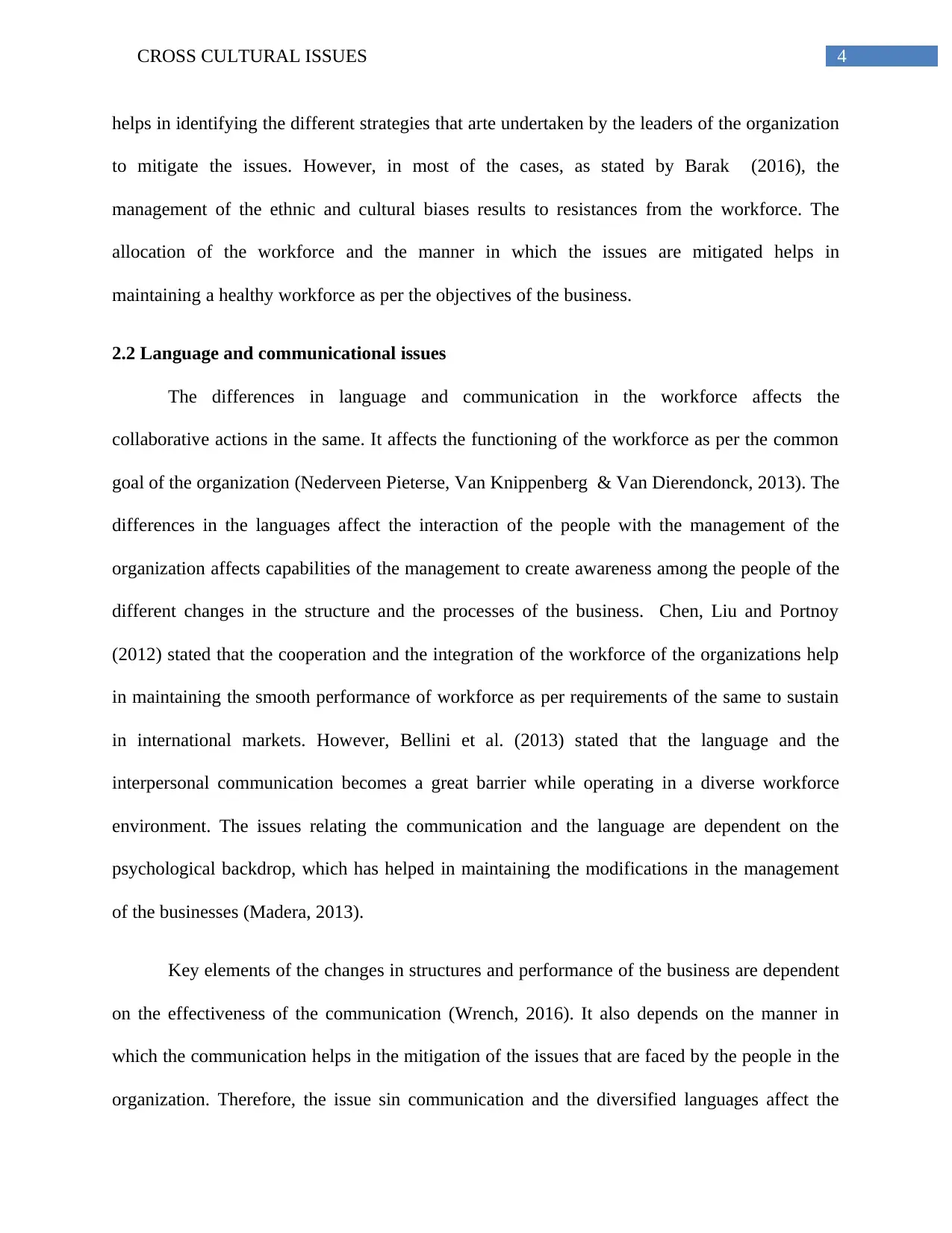
4CROSS CULTURAL ISSUES
helps in identifying the different strategies that arte undertaken by the leaders of the organization
to mitigate the issues. However, in most of the cases, as stated by Barak (2016), the
management of the ethnic and cultural biases results to resistances from the workforce. The
allocation of the workforce and the manner in which the issues are mitigated helps in
maintaining a healthy workforce as per the objectives of the business.
2.2 Language and communicational issues
The differences in language and communication in the workforce affects the
collaborative actions in the same. It affects the functioning of the workforce as per the common
goal of the organization (Nederveen Pieterse, Van Knippenberg & Van Dierendonck, 2013). The
differences in the languages affect the interaction of the people with the management of the
organization affects capabilities of the management to create awareness among the people of the
different changes in the structure and the processes of the business. Chen, Liu and Portnoy
(2012) stated that the cooperation and the integration of the workforce of the organizations help
in maintaining the smooth performance of workforce as per requirements of the same to sustain
in international markets. However, Bellini et al. (2013) stated that the language and the
interpersonal communication becomes a great barrier while operating in a diverse workforce
environment. The issues relating the communication and the language are dependent on the
psychological backdrop, which has helped in maintaining the modifications in the management
of the businesses (Madera, 2013).
Key elements of the changes in structures and performance of the business are dependent
on the effectiveness of the communication (Wrench, 2016). It also depends on the manner in
which the communication helps in the mitigation of the issues that are faced by the people in the
organization. Therefore, the issue sin communication and the diversified languages affect the
helps in identifying the different strategies that arte undertaken by the leaders of the organization
to mitigate the issues. However, in most of the cases, as stated by Barak (2016), the
management of the ethnic and cultural biases results to resistances from the workforce. The
allocation of the workforce and the manner in which the issues are mitigated helps in
maintaining a healthy workforce as per the objectives of the business.
2.2 Language and communicational issues
The differences in language and communication in the workforce affects the
collaborative actions in the same. It affects the functioning of the workforce as per the common
goal of the organization (Nederveen Pieterse, Van Knippenberg & Van Dierendonck, 2013). The
differences in the languages affect the interaction of the people with the management of the
organization affects capabilities of the management to create awareness among the people of the
different changes in the structure and the processes of the business. Chen, Liu and Portnoy
(2012) stated that the cooperation and the integration of the workforce of the organizations help
in maintaining the smooth performance of workforce as per requirements of the same to sustain
in international markets. However, Bellini et al. (2013) stated that the language and the
interpersonal communication becomes a great barrier while operating in a diverse workforce
environment. The issues relating the communication and the language are dependent on the
psychological backdrop, which has helped in maintaining the modifications in the management
of the businesses (Madera, 2013).
Key elements of the changes in structures and performance of the business are dependent
on the effectiveness of the communication (Wrench, 2016). It also depends on the manner in
which the communication helps in the mitigation of the issues that are faced by the people in the
organization. Therefore, the issue sin communication and the diversified languages affect the
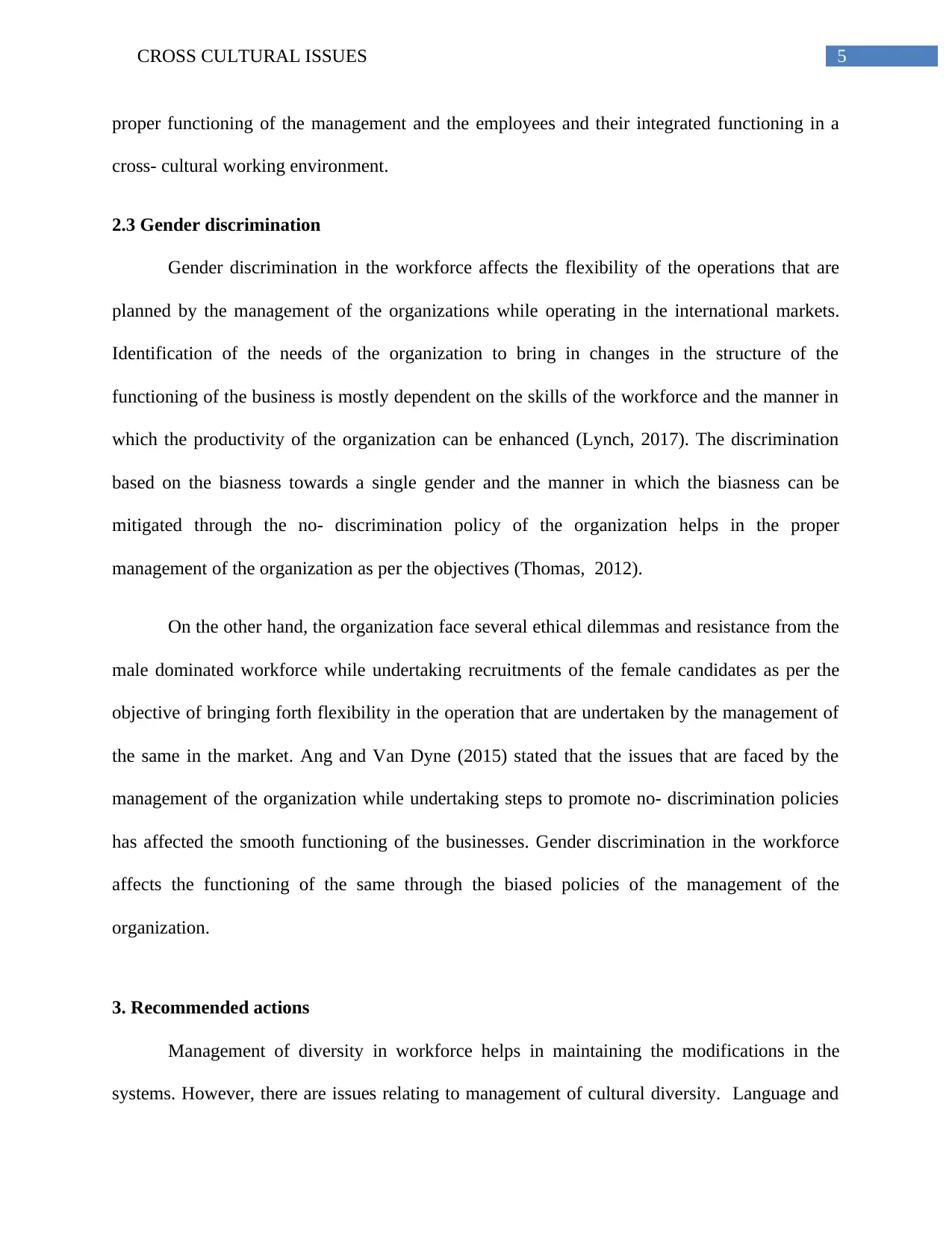
5CROSS CULTURAL ISSUES
proper functioning of the management and the employees and their integrated functioning in a
cross- cultural working environment.
2.3 Gender discrimination
Gender discrimination in the workforce affects the flexibility of the operations that are
planned by the management of the organizations while operating in the international markets.
Identification of the needs of the organization to bring in changes in the structure of the
functioning of the business is mostly dependent on the skills of the workforce and the manner in
which the productivity of the organization can be enhanced (Lynch, 2017). The discrimination
based on the biasness towards a single gender and the manner in which the biasness can be
mitigated through the no- discrimination policy of the organization helps in the proper
management of the organization as per the objectives (Thomas, 2012).
On the other hand, the organization face several ethical dilemmas and resistance from the
male dominated workforce while undertaking recruitments of the female candidates as per the
objective of bringing forth flexibility in the operation that are undertaken by the management of
the same in the market. Ang and Van Dyne (2015) stated that the issues that are faced by the
management of the organization while undertaking steps to promote no- discrimination policies
has affected the smooth functioning of the businesses. Gender discrimination in the workforce
affects the functioning of the same through the biased policies of the management of the
organization.
3. Recommended actions
Management of diversity in workforce helps in maintaining the modifications in the
systems. However, there are issues relating to management of cultural diversity. Language and
proper functioning of the management and the employees and their integrated functioning in a
cross- cultural working environment.
2.3 Gender discrimination
Gender discrimination in the workforce affects the flexibility of the operations that are
planned by the management of the organizations while operating in the international markets.
Identification of the needs of the organization to bring in changes in the structure of the
functioning of the business is mostly dependent on the skills of the workforce and the manner in
which the productivity of the organization can be enhanced (Lynch, 2017). The discrimination
based on the biasness towards a single gender and the manner in which the biasness can be
mitigated through the no- discrimination policy of the organization helps in the proper
management of the organization as per the objectives (Thomas, 2012).
On the other hand, the organization face several ethical dilemmas and resistance from the
male dominated workforce while undertaking recruitments of the female candidates as per the
objective of bringing forth flexibility in the operation that are undertaken by the management of
the same in the market. Ang and Van Dyne (2015) stated that the issues that are faced by the
management of the organization while undertaking steps to promote no- discrimination policies
has affected the smooth functioning of the businesses. Gender discrimination in the workforce
affects the functioning of the same through the biased policies of the management of the
organization.
3. Recommended actions
Management of diversity in workforce helps in maintaining the modifications in the
systems. However, there are issues relating to management of cultural diversity. Language and
⊘ This is a preview!⊘
Do you want full access?
Subscribe today to unlock all pages.

Trusted by 1+ million students worldwide
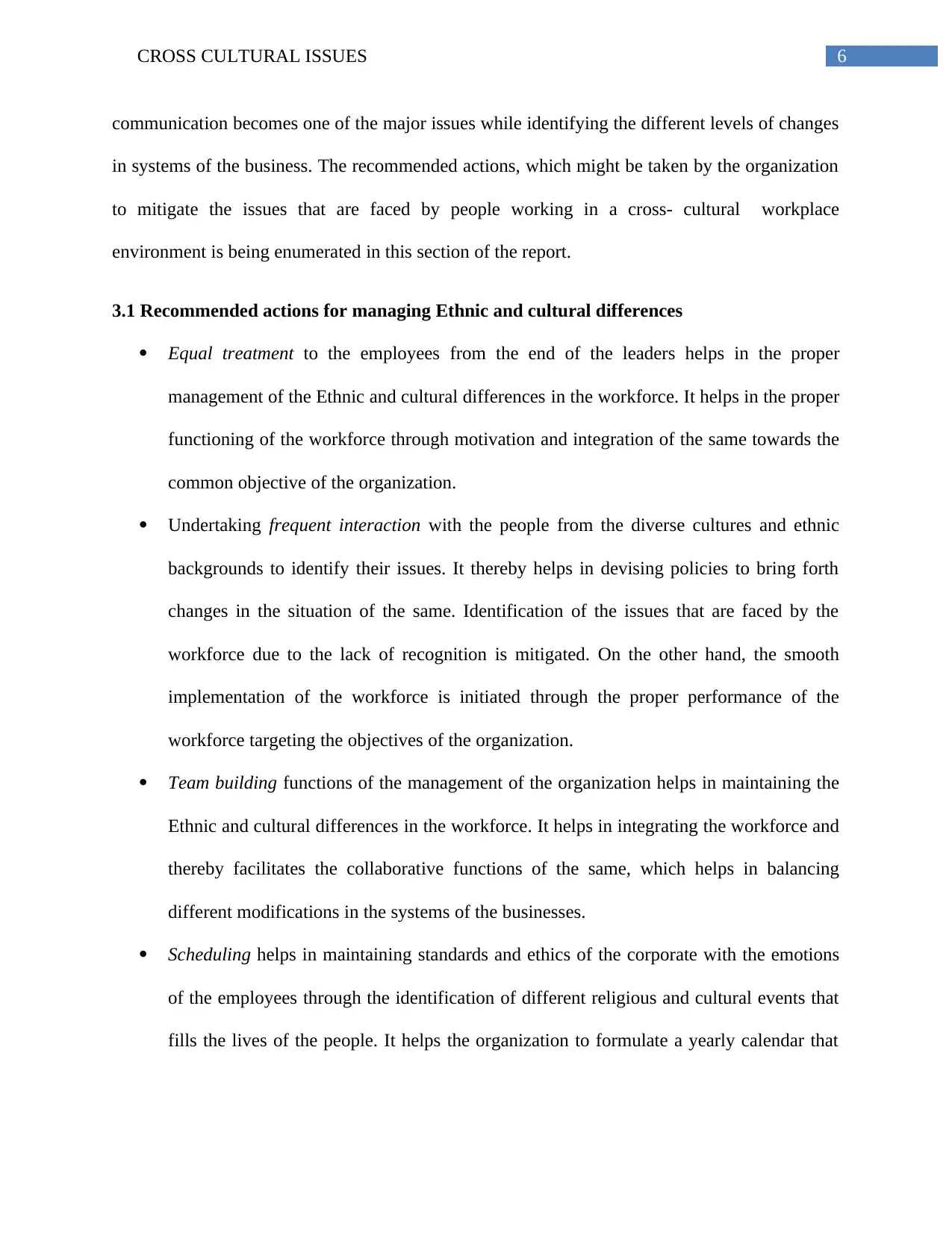
6CROSS CULTURAL ISSUES
communication becomes one of the major issues while identifying the different levels of changes
in systems of the business. The recommended actions, which might be taken by the organization
to mitigate the issues that are faced by people working in a cross- cultural workplace
environment is being enumerated in this section of the report.
3.1 Recommended actions for managing Ethnic and cultural differences
Equal treatment to the employees from the end of the leaders helps in the proper
management of the Ethnic and cultural differences in the workforce. It helps in the proper
functioning of the workforce through motivation and integration of the same towards the
common objective of the organization.
Undertaking frequent interaction with the people from the diverse cultures and ethnic
backgrounds to identify their issues. It thereby helps in devising policies to bring forth
changes in the situation of the same. Identification of the issues that are faced by the
workforce due to the lack of recognition is mitigated. On the other hand, the smooth
implementation of the workforce is initiated through the proper performance of the
workforce targeting the objectives of the organization.
Team building functions of the management of the organization helps in maintaining the
Ethnic and cultural differences in the workforce. It helps in integrating the workforce and
thereby facilitates the collaborative functions of the same, which helps in balancing
different modifications in the systems of the businesses.
Scheduling helps in maintaining standards and ethics of the corporate with the emotions
of the employees through the identification of different religious and cultural events that
fills the lives of the people. It helps the organization to formulate a yearly calendar that
communication becomes one of the major issues while identifying the different levels of changes
in systems of the business. The recommended actions, which might be taken by the organization
to mitigate the issues that are faced by people working in a cross- cultural workplace
environment is being enumerated in this section of the report.
3.1 Recommended actions for managing Ethnic and cultural differences
Equal treatment to the employees from the end of the leaders helps in the proper
management of the Ethnic and cultural differences in the workforce. It helps in the proper
functioning of the workforce through motivation and integration of the same towards the
common objective of the organization.
Undertaking frequent interaction with the people from the diverse cultures and ethnic
backgrounds to identify their issues. It thereby helps in devising policies to bring forth
changes in the situation of the same. Identification of the issues that are faced by the
workforce due to the lack of recognition is mitigated. On the other hand, the smooth
implementation of the workforce is initiated through the proper performance of the
workforce targeting the objectives of the organization.
Team building functions of the management of the organization helps in maintaining the
Ethnic and cultural differences in the workforce. It helps in integrating the workforce and
thereby facilitates the collaborative functions of the same, which helps in balancing
different modifications in the systems of the businesses.
Scheduling helps in maintaining standards and ethics of the corporate with the emotions
of the employees through the identification of different religious and cultural events that
fills the lives of the people. It helps the organization to formulate a yearly calendar that
Paraphrase This Document
Need a fresh take? Get an instant paraphrase of this document with our AI Paraphraser
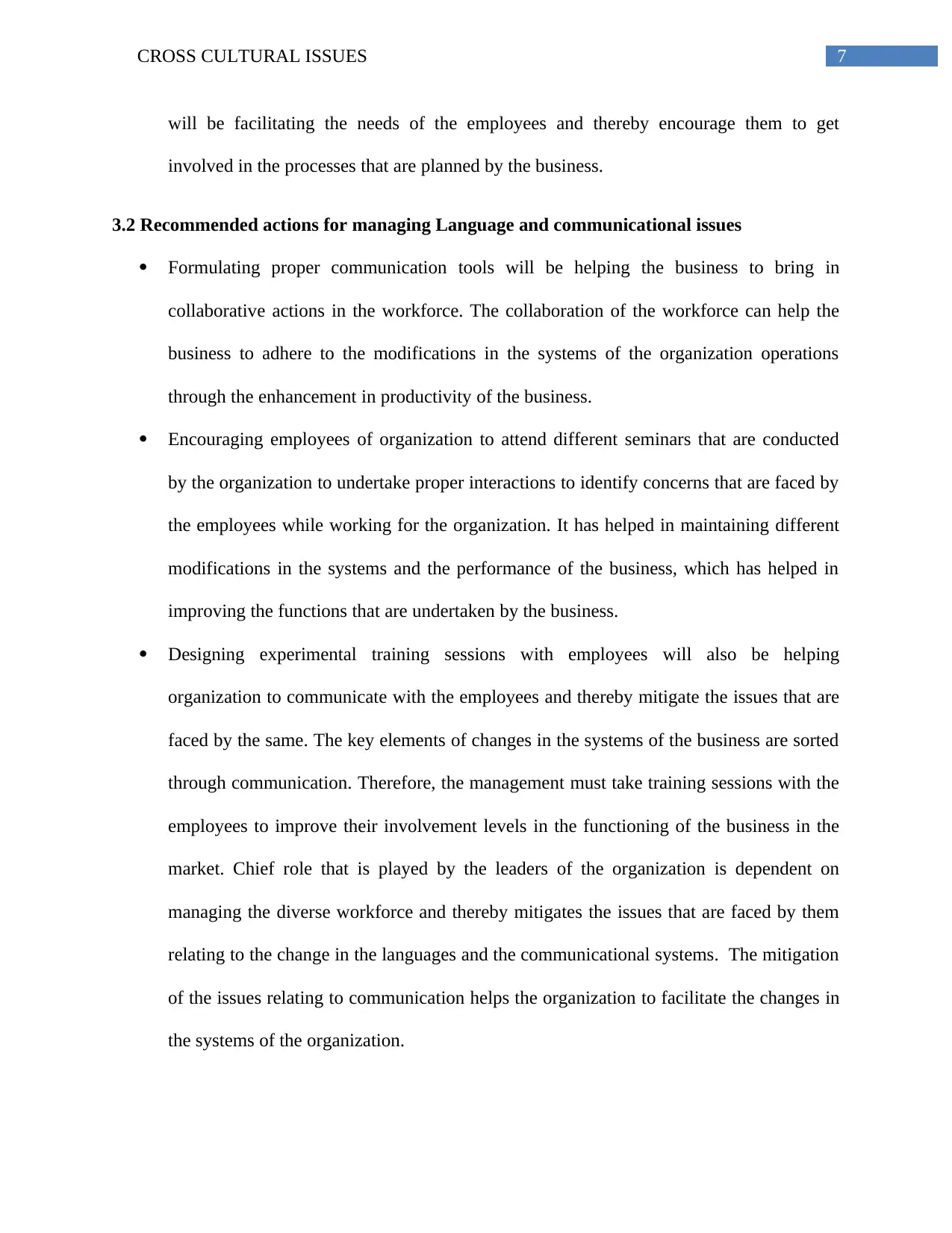
7CROSS CULTURAL ISSUES
will be facilitating the needs of the employees and thereby encourage them to get
involved in the processes that are planned by the business.
3.2 Recommended actions for managing Language and communicational issues
Formulating proper communication tools will be helping the business to bring in
collaborative actions in the workforce. The collaboration of the workforce can help the
business to adhere to the modifications in the systems of the organization operations
through the enhancement in productivity of the business.
Encouraging employees of organization to attend different seminars that are conducted
by the organization to undertake proper interactions to identify concerns that are faced by
the employees while working for the organization. It has helped in maintaining different
modifications in the systems and the performance of the business, which has helped in
improving the functions that are undertaken by the business.
Designing experimental training sessions with employees will also be helping
organization to communicate with the employees and thereby mitigate the issues that are
faced by the same. The key elements of changes in the systems of the business are sorted
through communication. Therefore, the management must take training sessions with the
employees to improve their involvement levels in the functioning of the business in the
market. Chief role that is played by the leaders of the organization is dependent on
managing the diverse workforce and thereby mitigates the issues that are faced by them
relating to the change in the languages and the communicational systems. The mitigation
of the issues relating to communication helps the organization to facilitate the changes in
the systems of the organization.
will be facilitating the needs of the employees and thereby encourage them to get
involved in the processes that are planned by the business.
3.2 Recommended actions for managing Language and communicational issues
Formulating proper communication tools will be helping the business to bring in
collaborative actions in the workforce. The collaboration of the workforce can help the
business to adhere to the modifications in the systems of the organization operations
through the enhancement in productivity of the business.
Encouraging employees of organization to attend different seminars that are conducted
by the organization to undertake proper interactions to identify concerns that are faced by
the employees while working for the organization. It has helped in maintaining different
modifications in the systems and the performance of the business, which has helped in
improving the functions that are undertaken by the business.
Designing experimental training sessions with employees will also be helping
organization to communicate with the employees and thereby mitigate the issues that are
faced by the same. The key elements of changes in the systems of the business are sorted
through communication. Therefore, the management must take training sessions with the
employees to improve their involvement levels in the functioning of the business in the
market. Chief role that is played by the leaders of the organization is dependent on
managing the diverse workforce and thereby mitigates the issues that are faced by them
relating to the change in the languages and the communicational systems. The mitigation
of the issues relating to communication helps the organization to facilitate the changes in
the systems of the organization.
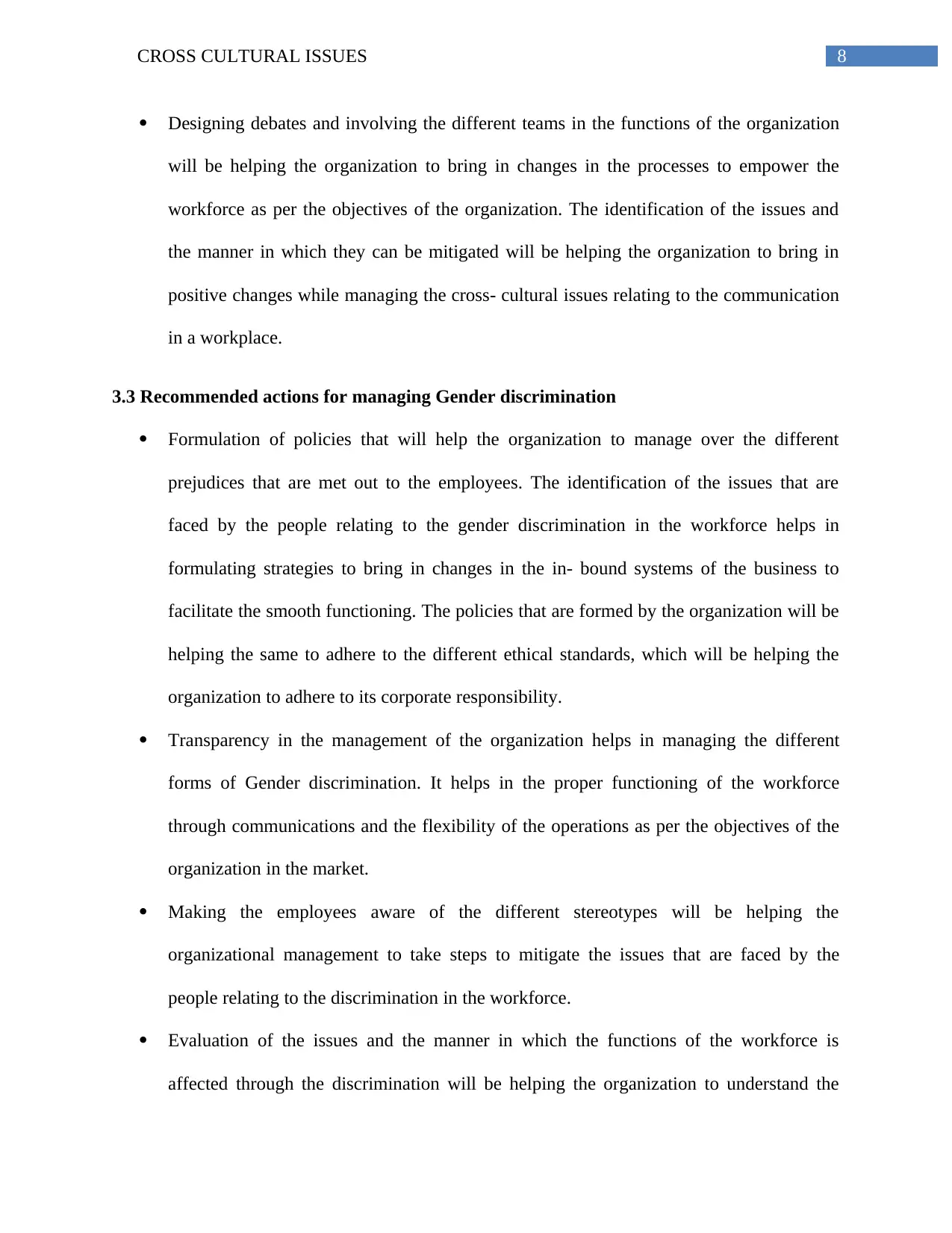
8CROSS CULTURAL ISSUES
Designing debates and involving the different teams in the functions of the organization
will be helping the organization to bring in changes in the processes to empower the
workforce as per the objectives of the organization. The identification of the issues and
the manner in which they can be mitigated will be helping the organization to bring in
positive changes while managing the cross- cultural issues relating to the communication
in a workplace.
3.3 Recommended actions for managing Gender discrimination
Formulation of policies that will help the organization to manage over the different
prejudices that are met out to the employees. The identification of the issues that are
faced by the people relating to the gender discrimination in the workforce helps in
formulating strategies to bring in changes in the in- bound systems of the business to
facilitate the smooth functioning. The policies that are formed by the organization will be
helping the same to adhere to the different ethical standards, which will be helping the
organization to adhere to its corporate responsibility.
Transparency in the management of the organization helps in managing the different
forms of Gender discrimination. It helps in the proper functioning of the workforce
through communications and the flexibility of the operations as per the objectives of the
organization in the market.
Making the employees aware of the different stereotypes will be helping the
organizational management to take steps to mitigate the issues that are faced by the
people relating to the discrimination in the workforce.
Evaluation of the issues and the manner in which the functions of the workforce is
affected through the discrimination will be helping the organization to understand the
Designing debates and involving the different teams in the functions of the organization
will be helping the organization to bring in changes in the processes to empower the
workforce as per the objectives of the organization. The identification of the issues and
the manner in which they can be mitigated will be helping the organization to bring in
positive changes while managing the cross- cultural issues relating to the communication
in a workplace.
3.3 Recommended actions for managing Gender discrimination
Formulation of policies that will help the organization to manage over the different
prejudices that are met out to the employees. The identification of the issues that are
faced by the people relating to the gender discrimination in the workforce helps in
formulating strategies to bring in changes in the in- bound systems of the business to
facilitate the smooth functioning. The policies that are formed by the organization will be
helping the same to adhere to the different ethical standards, which will be helping the
organization to adhere to its corporate responsibility.
Transparency in the management of the organization helps in managing the different
forms of Gender discrimination. It helps in the proper functioning of the workforce
through communications and the flexibility of the operations as per the objectives of the
organization in the market.
Making the employees aware of the different stereotypes will be helping the
organizational management to take steps to mitigate the issues that are faced by the
people relating to the discrimination in the workforce.
Evaluation of the issues and the manner in which the functions of the workforce is
affected through the discrimination will be helping the organization to understand the
⊘ This is a preview!⊘
Do you want full access?
Subscribe today to unlock all pages.

Trusted by 1+ million students worldwide
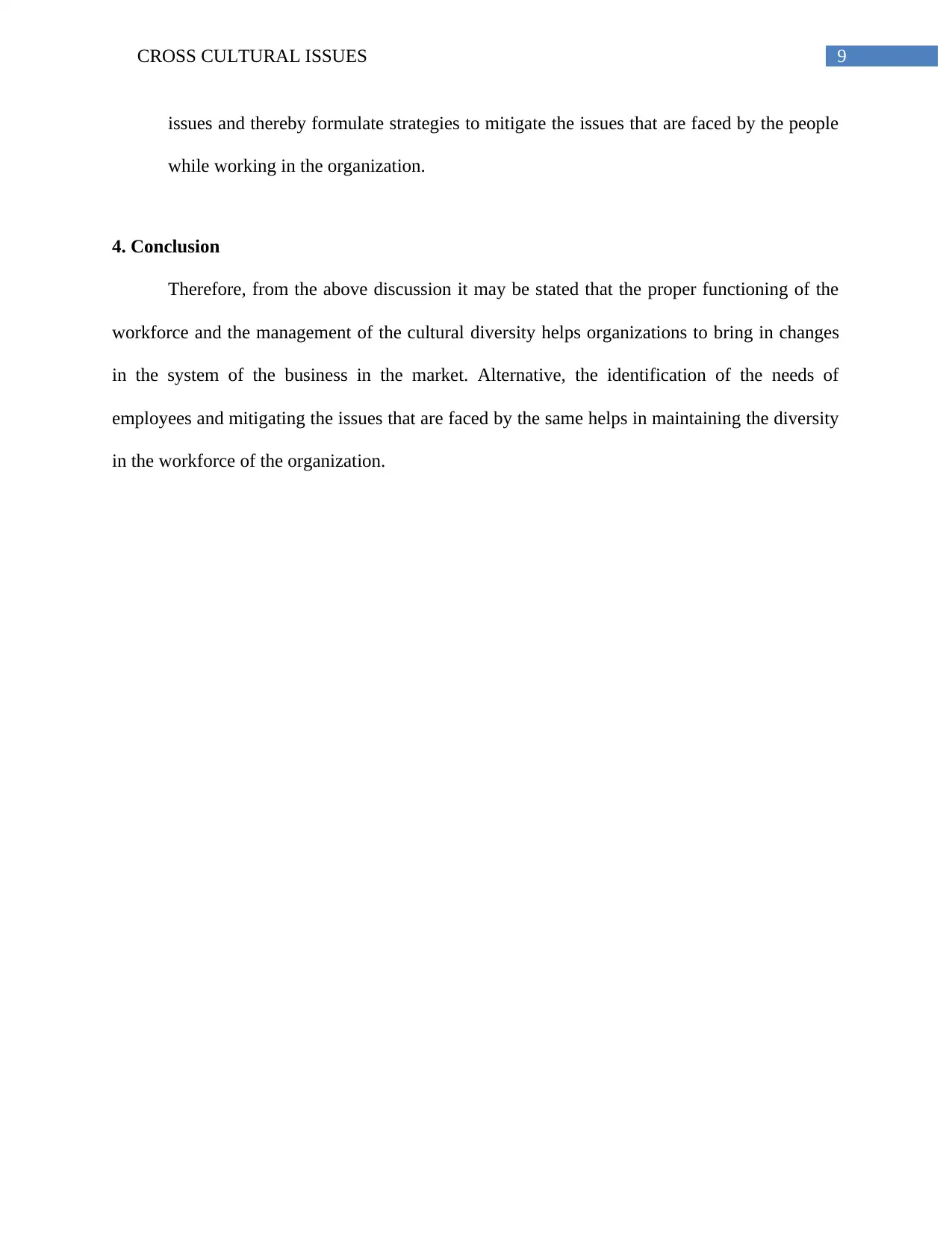
9CROSS CULTURAL ISSUES
issues and thereby formulate strategies to mitigate the issues that are faced by the people
while working in the organization.
4. Conclusion
Therefore, from the above discussion it may be stated that the proper functioning of the
workforce and the management of the cultural diversity helps organizations to bring in changes
in the system of the business in the market. Alternative, the identification of the needs of
employees and mitigating the issues that are faced by the same helps in maintaining the diversity
in the workforce of the organization.
issues and thereby formulate strategies to mitigate the issues that are faced by the people
while working in the organization.
4. Conclusion
Therefore, from the above discussion it may be stated that the proper functioning of the
workforce and the management of the cultural diversity helps organizations to bring in changes
in the system of the business in the market. Alternative, the identification of the needs of
employees and mitigating the issues that are faced by the same helps in maintaining the diversity
in the workforce of the organization.
Paraphrase This Document
Need a fresh take? Get an instant paraphrase of this document with our AI Paraphraser
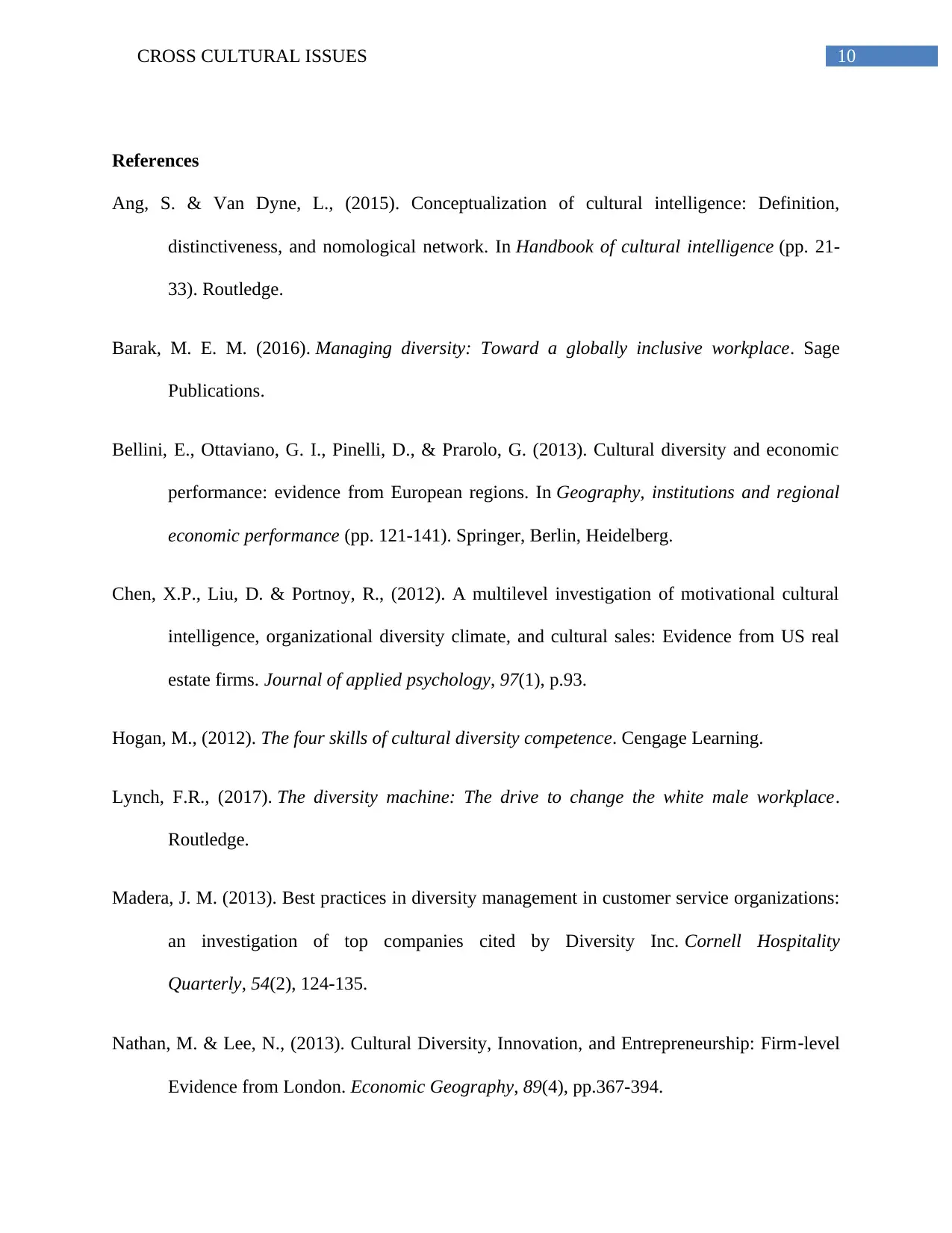
10CROSS CULTURAL ISSUES
References
Ang, S. & Van Dyne, L., (2015). Conceptualization of cultural intelligence: Definition,
distinctiveness, and nomological network. In Handbook of cultural intelligence (pp. 21-
33). Routledge.
Barak, M. E. M. (2016). Managing diversity: Toward a globally inclusive workplace. Sage
Publications.
Bellini, E., Ottaviano, G. I., Pinelli, D., & Prarolo, G. (2013). Cultural diversity and economic
performance: evidence from European regions. In Geography, institutions and regional
economic performance (pp. 121-141). Springer, Berlin, Heidelberg.
Chen, X.P., Liu, D. & Portnoy, R., (2012). A multilevel investigation of motivational cultural
intelligence, organizational diversity climate, and cultural sales: Evidence from US real
estate firms. Journal of applied psychology, 97(1), p.93.
Hogan, M., (2012). The four skills of cultural diversity competence. Cengage Learning.
Lynch, F.R., (2017). The diversity machine: The drive to change the white male workplace.
Routledge.
Madera, J. M. (2013). Best practices in diversity management in customer service organizations:
an investigation of top companies cited by Diversity Inc. Cornell Hospitality
Quarterly, 54(2), 124-135.
Nathan, M. & Lee, N., (2013). Cultural Diversity, Innovation, and Entrepreneurship: Firm‐level
Evidence from London. Economic Geography, 89(4), pp.367-394.
References
Ang, S. & Van Dyne, L., (2015). Conceptualization of cultural intelligence: Definition,
distinctiveness, and nomological network. In Handbook of cultural intelligence (pp. 21-
33). Routledge.
Barak, M. E. M. (2016). Managing diversity: Toward a globally inclusive workplace. Sage
Publications.
Bellini, E., Ottaviano, G. I., Pinelli, D., & Prarolo, G. (2013). Cultural diversity and economic
performance: evidence from European regions. In Geography, institutions and regional
economic performance (pp. 121-141). Springer, Berlin, Heidelberg.
Chen, X.P., Liu, D. & Portnoy, R., (2012). A multilevel investigation of motivational cultural
intelligence, organizational diversity climate, and cultural sales: Evidence from US real
estate firms. Journal of applied psychology, 97(1), p.93.
Hogan, M., (2012). The four skills of cultural diversity competence. Cengage Learning.
Lynch, F.R., (2017). The diversity machine: The drive to change the white male workplace.
Routledge.
Madera, J. M. (2013). Best practices in diversity management in customer service organizations:
an investigation of top companies cited by Diversity Inc. Cornell Hospitality
Quarterly, 54(2), 124-135.
Nathan, M. & Lee, N., (2013). Cultural Diversity, Innovation, and Entrepreneurship: Firm‐level
Evidence from London. Economic Geography, 89(4), pp.367-394.
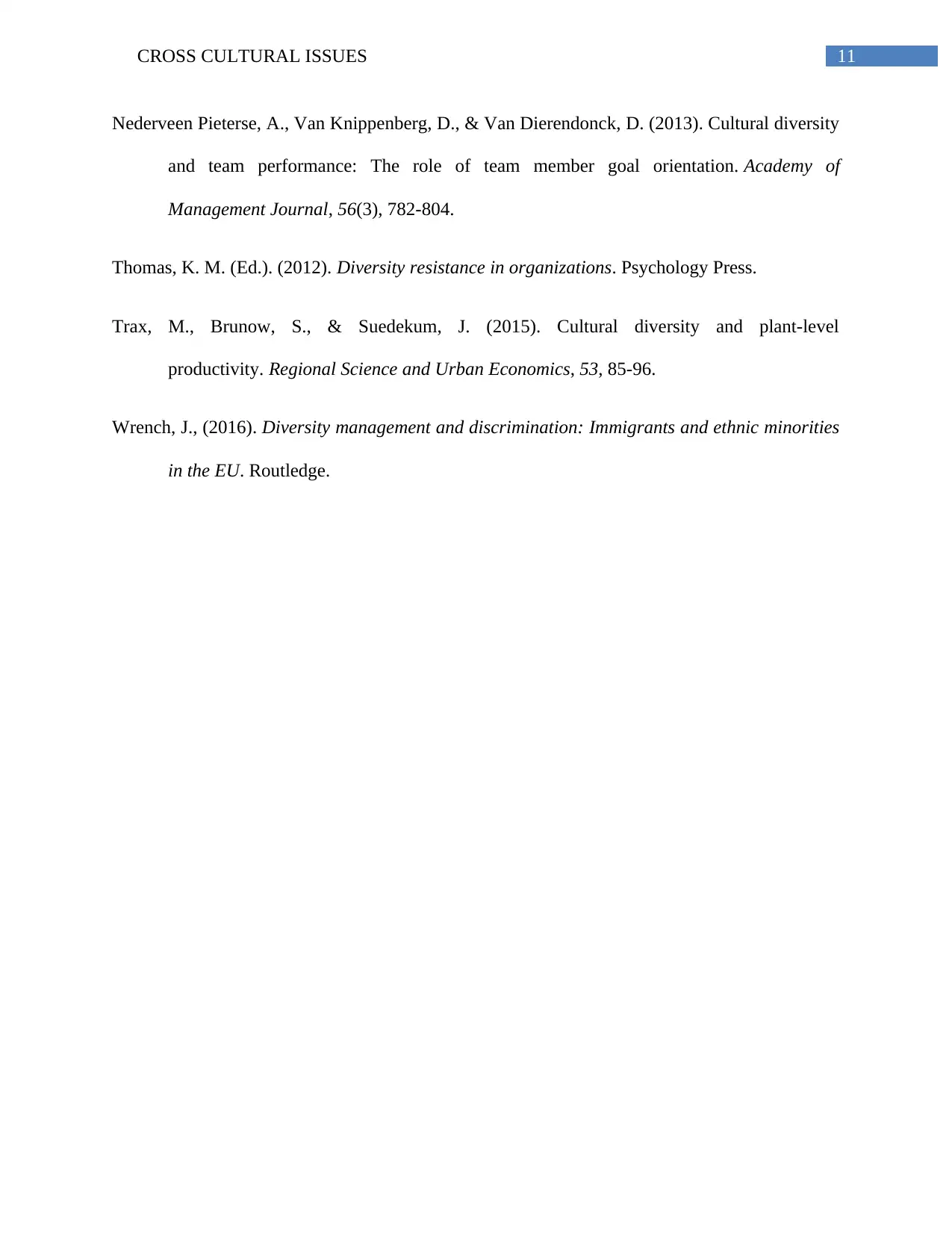
11CROSS CULTURAL ISSUES
Nederveen Pieterse, A., Van Knippenberg, D., & Van Dierendonck, D. (2013). Cultural diversity
and team performance: The role of team member goal orientation. Academy of
Management Journal, 56(3), 782-804.
Thomas, K. M. (Ed.). (2012). Diversity resistance in organizations. Psychology Press.
Trax, M., Brunow, S., & Suedekum, J. (2015). Cultural diversity and plant-level
productivity. Regional Science and Urban Economics, 53, 85-96.
Wrench, J., (2016). Diversity management and discrimination: Immigrants and ethnic minorities
in the EU. Routledge.
Nederveen Pieterse, A., Van Knippenberg, D., & Van Dierendonck, D. (2013). Cultural diversity
and team performance: The role of team member goal orientation. Academy of
Management Journal, 56(3), 782-804.
Thomas, K. M. (Ed.). (2012). Diversity resistance in organizations. Psychology Press.
Trax, M., Brunow, S., & Suedekum, J. (2015). Cultural diversity and plant-level
productivity. Regional Science and Urban Economics, 53, 85-96.
Wrench, J., (2016). Diversity management and discrimination: Immigrants and ethnic minorities
in the EU. Routledge.
⊘ This is a preview!⊘
Do you want full access?
Subscribe today to unlock all pages.

Trusted by 1+ million students worldwide
1 out of 12
Related Documents
Your All-in-One AI-Powered Toolkit for Academic Success.
+13062052269
info@desklib.com
Available 24*7 on WhatsApp / Email
![[object Object]](/_next/static/media/star-bottom.7253800d.svg)
Unlock your academic potential
Copyright © 2020–2025 A2Z Services. All Rights Reserved. Developed and managed by ZUCOL.





